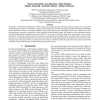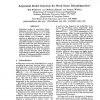111 search results - page 5 / 23 » A Concept-based Adaptive Approach to Word Sense Disambiguati... |
COLING
1990
13 years 8 months ago
1990
In this paper, we describe a means for automatically building very large neural networks (VLNNs) from definition texts in machine-readable dictionaries, and demonstrate the use of...
LREC
2010
13 years 9 months ago
2010
We propose a Word Sense Disambiguation (WSD) method that accurately classifies ambiguous words to concepts in the Associative Concept Dictionary (ACD) even when the test corpus an...
BMCBI
2010
13 years 7 months ago
2010
Background: Word sense disambiguation (WSD) algorithms attempt to select the proper sense of ambiguous terms in text. Resources like the UMLS provide a reference thesaurus to be u...
ECAI
2000
Springer
13 years 12 months ago
2000
Springer
Abstract. This paper describes an experimental comparison between two standard supervised learning methods, namely Naive Bayes and Exemplar–basedclassification, on the Word Sens...
ANLP
1997
13 years 9 months ago
1997
Statistical models of word-sense disambiguation are often based on a small number of contextual features or on a model that is assumed to characterize the interactions among a set...


